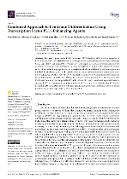Combined Approach to Leukemic Differentiation Using Transcription Factor PU.1-Enhancing Agents

Autor
Datum vydání
2022Publikováno v
International Journal of Molecular Sciences [online]Ročník / Číslo vydání
23 (12)ISBN / ISSN
ISSN: 1661-6596Informace o financování
MZ0/NV/NV19-08-00144
MZ0/NU/NU21-08-00312
UK/GAUK/GAUK1672119
UK/UNCE/MED/UNCE/MED/016
UK/SVV/SVV260521
UK/PROGRES/Q26
UK/COOP/COOP
MZ0/NU/NU22-05-00374
MSM//LX22NPO5102
Metadata
Zobrazit celý záznamKolekce
Tato publikace má vydavatelskou verzi s DOI 10.3390/ijms23126729
Abstrakt
The transcription factor PU.1 (Purine-rich DNA binding, SPI1) is a key regulator of hematopoiesis, whose level is influenced by transcription through its enhancers and its post-transcriptional degradation via microRNA-155 (miR-155). The degree of transcriptional regulation of the PU.1 gene is influenced by repression via DNA methylation, as well as other epigenetic factors, such as those related to progenitor maturation status, which is modulated by the transcription factor Myeloblastosis oncogene (MYB). In this work, we show that combinatorial treatment of acute myeloid leukemia (AML) cells with DNA methylation inhibitors (5-Azacytidine), MYB inhibitors (Celastrol), and anti-miR-155 (AM155) ideally leads to overproduction of PU.1. We also show that PU.1 reactivation can be compensated by miR-155 and that only a combined approach leads to sustained PU.1 derepression, even at the protein level. The triple effect on increasing PU.1 levels in myeloblasts stimulates the myeloid transcriptional program while inhibiting cell survival and proliferation, leading to partial leukemic differentiation.
Klíčová slova
transcription factor PU, 1, microRNA miR-155, 5-Azacytidine, Celastrol
Trvalý odkaz
https://hdl.handle.net/20.500.14178/2033Licence
Licence pro užití plného textu výsledku: Creative Commons Uveďte původ 4.0 International







